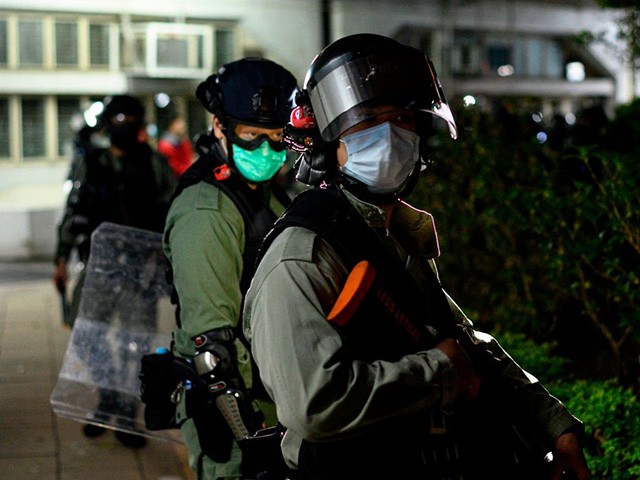Thousands of fully armed riot police took the streets of Hong Kong on Wednesday to crack down on multiple peaceful protests organized against legislation that pro-democracy activists say would criminalize dissent against the Chinese Communist Party, arresting around 300 people, including many minors.
Reports differed on the number of those arrested between describing it as “nearly 300” or “at least 300” people. Police authorities confirmed that the range of ages among the arrested spanned from 16 to 60, according to the Hong Kong Free Press (HKFP), among those arrested in the first round of lunchtime protests by 11:30 a.m. local time. Protesters took the streets in fuller force around 5 p.m. local time, resulting in harrowing scenes in which riot police attacked with pepper pellets and filled buses with detained protesters, many wearing their school uniforms.
As Hong Kong approaches the anniversary of its pro-democracy movement, it faces the dual threats of a proposed law in its Legislative Council (LegCo) prescribing up to three years in prison for “disrespect” of communist China’s national anthem, the “March of the Volunteers,” and a Beijing “national security” law meant to gut the power of local authorities to protect free speech. LegCo began debate on the national anthem law on Wednesday; China’s “National People’s Congress,” its communist rubber-stamp legislature, began work on the “national security” bill this week.
The city’s pro-democracy movement managed to attract millions to its protests throughout 2019. Protesters remained at home for several months in adherence to social distancing measures taken to contain the spread of the Chinese coronavirus, but swiftly returned in force this month after Hong Kong authorities loosened restrictions on gatherings. Gatherings of more than eight people in public remain illegal, however, until June 5. June 4 is the anniversary of the Tiananmen Square massacre in 1989, which Hong Kong residents have marked with a thousands-strong candlelight vigil since 1990. Pro-democracy advocates have organized a “socially distant” version of the event this year.
Reports of protests on Wednesday surfaced throughout the city. The Asian outlet Coconuts identified the districts of Causeway Bay, Central, and Mong Kok as flash points for protests, where activists marched and chanted slogans like “Hong Kongers, build our nation.” Some also used the slogan adopted by the protesters last year – “five demands, not one less” – despite the fact that they were protesting new developments outside of the scope of those demands.
Hong Kong protesters listed as their “five demands” last year the withdrawal of a bill that would have allowed China to extradite anyone present in Hong Kong if accused of communist “crimes,” universal suffrage for all public offices, freedom for political prisoners, an investigation into police brutality, and an end to calling protesters “rioters.” Hong Kong Chief Executive Carrie Lam only ceded the withdrawal of the extradition bill, now replaced by the national anthem bill and Beijing’s “national security” law.
Some of the most violent police activity on Wednesday reportedly occurred in Central, where Coconuts reports that police used pepper balls to incapacitate protesters. RTHK, the local broadcaster, also reported that police threats resulted in protesters running through the streets as police “set up cordons to hold members of the press back.”
Local journalists published shocking images from Causeway Bay, as well, where police appeared to corral young protesters and make them sit on the floor while waiting for a bus to take them to police stations for formal arrest. Stand News published video of what clearly appeared to be a forced police gathering of more than eight people, violating Chinese coronavirus restrictions, huddling together, none appearing to be resisting or engaging in violence.
Police claimed in a statement to have arrested “some 180 persons for participating in unauthorized assembly” in Causeway Bay and Central.
Protesters in Mong Kok staged a march along the area’s Nathan Road, also chanting pro-democracy and pro-independence slogans. Coconuts reported the violent detention of at least one man, seen pressed into the ground in a pool of his own blood.
At press time, journalists on the scene are sharing videos from Nathan Road indicating that, despite the mass arrests of dozens participating in the march, more protesters are continuing to convene there.
One area where police apparently did not encounter protesters was the outside facade of LegCo, where police “erected water barriers, sealed pavement bricks and secured metal fences – often used by protesters to form roadblocks – around the Central Government Offices,” the HKFP reported. Police prepared for violence there in observance of the recent history of the protest movement, which resulted in the ransacking of the LegCo headquarters last year.
In July, protesters stormed the building, destroying the legislative floor and nearly all technical equipment necessary to pass laws, preventing debate on the extradition bill. While they did vandalize many of the walls of the building and break some of its glass exterior, the protesters were also careful not to injure anyone or vandalize any of the historical documents kept there. Protesters were also seen going into the building’s cafeteria and taking drinks, but leaving cash in the refrigerators holding refreshments. Officials estimated the damage to surpass $1 million in value.
Nothing of the sort happened on Wednesday, however, and LegCo proceedings went on as usual, only slightly hindered by pro-democracy lawmakers using procedural tools to delay pushing the national anthem bill forward.
